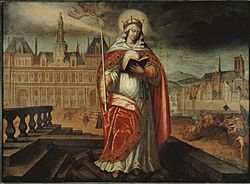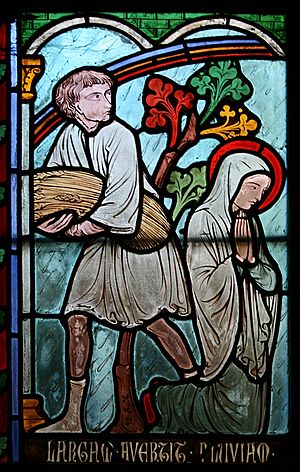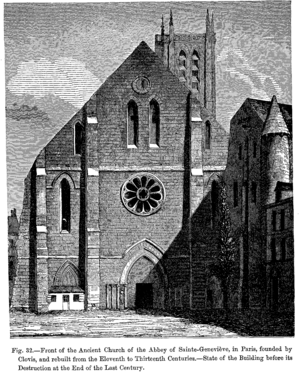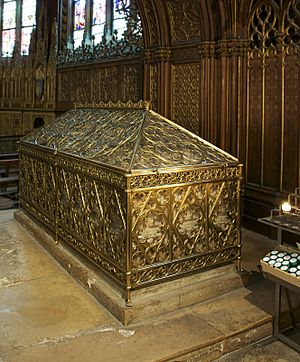Genevieve facts for kids
Quick facts for kids SaintGenevieve |
|
|---|---|

Saint Genevieve, 17th-century painting, Musée Carnavalet, Paris
|
|
| Virgin | |
| Born | c. 419–422 Nanterre, Western Roman Empire |
| Died | 502–512 (aged 79–93) Paris, Francia |
| Venerated in | Catholic Church Orthodox Church |
| Canonized | Pre-congregation |
| Feast | 3 January, translation of relics (in Paris) 28 October, evelation of the relics 10 January |
| Attributes | Lit candle, breviary, angels and demons, liturgical vessel, crown, keys of the city of Paris |
| Patronage | Paris, shepherds, winemakers, wax-chandlers, hatmakers; against eye complaints, fever, plagues, drought, war |
Saint Genevieve (pronounced Jen-uh-veev) is a very important patron saint of Paris, France. She is honored in both the Catholic and Orthodox traditions. Her special day is celebrated on January 3rd.
Genevieve was born in a town called Nanterre, near Paris. She moved to Paris (which was then known as Lutetia) when she was young. She decided to dedicate her life to God. In 451 AD, she helped save Paris from Attila and his army, the Huns, through her prayers. Later, when the city was under attack by King Childeric I, Genevieve bravely helped the people. She brought food and convinced the king to release prisoners.
Her fame grew, and she became the patron saint of Paris. Many people believe she performed miracles and helped protect the city.
Contents
The Life of Saint Genevieve

Genevieve's story is a mix of history and religious tales. She was born in Nanterre to a family of farmers. When she was very young, a holy man named Germanus of Auxerre visited her town. Genevieve told him she wanted to live a life dedicated to God. He encouraged her, and at 15, she became a consecrated virgin. This meant she promised to live a pure life focused on her faith.
After her parents passed away, Genevieve moved to Paris to live with her godmother. In Paris, she became known for her deep faith and kindness. She spent her time helping others and praying. She also fasted often, meaning she would go without food or eat very little. Some people were jealous or didn't believe her, but Germanus helped her overcome their doubts.
Genevieve often had visions, seeing heavenly saints and angels. The Bishop of Paris asked her to guide other consecrated virgins. She led them by her example and teachings.
Saving Paris from the Huns
In 451 AD, a fearsome army called the Huns, led by Attila, was heading towards Paris. Everyone was terrified and wanted to flee the city. But Genevieve, along with Germanus's assistant, told the people not to run away. Instead, she urged them to pray. It is said that because of Genevieve's prayers, Attila's army changed direction and went to Orléans instead of Paris. This saved the city from destruction.
Helping During the Siege
Later, around 464 AD, King Childeric I and his army surrounded Paris. This was a difficult time for the city, as no food could get in. Genevieve bravely traveled by boat through the enemy lines to Troyes. She brought back much-needed grain to feed the starving people of Paris. She also spoke with King Childeric and asked him to be kind to the prisoners. Childeric listened to her and showed mercy to the people of Paris.
Building a Chapel
Genevieve greatly admired Saint Denis, another important French saint. She wanted to build a chapel in his honor where his holy relics could be kept. Around 475 AD, she bought land for the chapel. When workers said they couldn't find enough building materials, Genevieve helped them discover a hidden supply of lime. Thanks to her efforts, the chapel was built and became a popular place for pilgrims.
Genevieve is often shown with a lit candle, bread, keys, or a herd of animals. Sometimes, she is even shown with the devil, who is said to have tried to blow out her candle when she went to pray at night.
Death and Resting Place
After Genevieve's death, King Clovis I built an abbey where she was buried. This church became a very important place. Many people believed miracles happened at her tomb. The church was named after Saint Genevieve. Over time, people gave gifts to the church, making it very rich. It was attacked by Vikings in 847 AD but was rebuilt.
In 1129, Paris suffered from a terrible sickness called "burning sickness" (ergot poisoning). The sickness stopped after Saint Genevieve's holy relics were carried through the streets in a public procession. This event is still remembered in Paris churches today.
Later, in the 1700s, King Louis XV wanted a grand new church for the patron saint of Paris. He hired an architect named Jacques-Germain Soufflot to design it. This new church was built in a beautiful, classical style.
However, before the new church was finished, the French Revolution began. In 1791, the church was taken over by the government and renamed the Panthéon. It became a burial place for famous French people instead of a church.
During the Revolution, Saint Genevieve's holy relics were sadly burned in public. Even though the relics were mostly destroyed, the Panthéon was sometimes used as a Catholic church again. Today, the Panthéon is a famous monument in Paris.
Images for kids
See also
 In Spanish: Genoveva de París para niños
In Spanish: Genoveva de París para niños
- History of France
- Religion in France
- Roman Catholicism in France
- Saint Genevieve, patron saint archive




